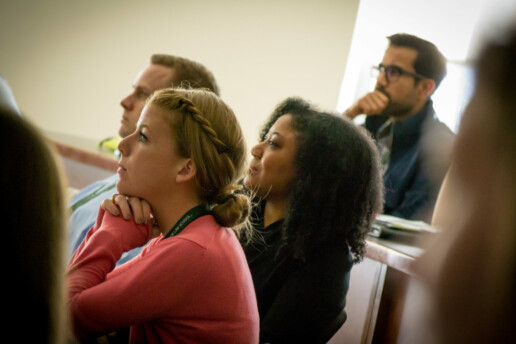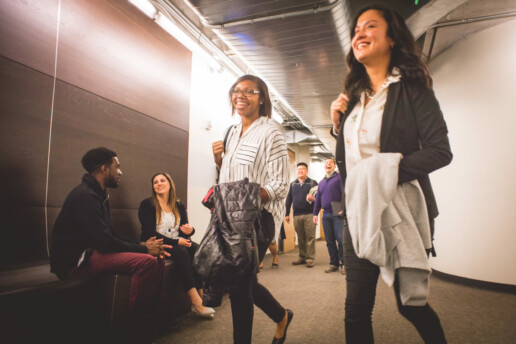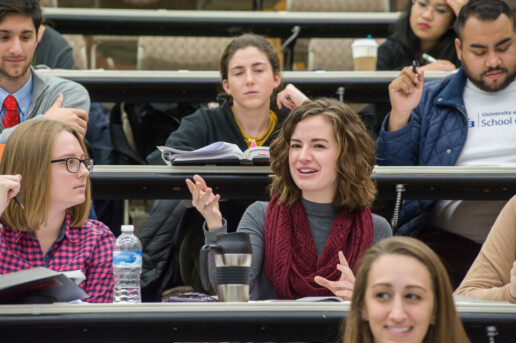Guest Post: LSSSE Data Illustrates Public Service Intent Among Asian American Law Students
Aryssa Ham
Undergraduate Researcher
University of California, Davis
Public Service Intent Among Asian American Law Students
What drives people to set aside their personal interests to help the collective? In 2017, Yale Law School and the National Asian Pacific American Bar Association found that Asian Americans gravitate towards careers in law firms and business over the public sector more than any other racial group, with few Asian Americans citing a desire to enter government as motivation to attend law school (Chung et al. 2017). Prior studies on the underrepresentation of racial minorities within the legal field often point to lack of academic or financial support as barriers to public service; yet Asian Americans were found to be the highest earning racial group in the U.S. and were overrepresented in top law schools (Sabharwal & Geva-May 2013; Kochhar & Cilluffo 2018; Chung et al. 2017).
This prompts a string of questions: Why are Asian Americans drawn to the private sector of the legal field? Why are they underrepresented in government and public interest? Alternatively, do Asian Americans prefer other forms of public service, such as pro bono work? If so, why doesn’t any other racial group appear to parallel this preference?
Despite past studies noting a weaker interest in the public sector among Asian Americans, few delve into potential explanations or examine variances among ethnicity. The original rallying, pan-ethnic Asian American identity has become a racial label that eclipses meaningful differences, propagating the Model Minority stereotype (Wu 2014:246). This social construct manifests in overlooked outcome disparities within the Asian American community, thus making ethnicity especially critical to examine.
As an undergraduate studying both psychology and sociology, I began an honors thesis last summer that integrates my majors: taking career decisions—a private, subjective experience—and zooming out to explore how these decisions interact with how society is organized and maintained. In my thesis, I study the professional trajectories of Asian Americans within the legal field—particularly the factors that determine whether and when an individual enters, stays, or switches into the public or private sector. Ultimately, I aim to shed light on why the legal profession is an underused entryway into government for Asian Americans, while simultaneously revealing the contrasting stories that vary by ethnicity.
Why LSSSE data?
I examine the extracurricular activities of law students to uncover patterns among students exhibiting public service motivation before fully entering the legal field. Although students can enter law school at different points in their life, I treat law school extracurriculars as the first major professional fork between the public and private sector.
While LSSSE data on student pro bono experiences are publicly accessible, ethnicity data are not shared on the website. After reaching out to Professor Meera Deo and LSSSE, they graciously provided the 2019 analyses that I needed.
I looked at 3 LSSSE Questions:
The first question (Pro Bono) asked for the number of hours a student spends each week doing legal pro bono work not required for a class or clinical course. The second (Public Service) asks if a student has done or plans to do pro bono work or public service before graduation, with response options "undecided," "do not plan to do," "plan to do," or "done." The final question (Clinical Project) asks how often a student has participated in a clinical or pro bono project as part of a course or for academic credit, with response options ranging from "never" to "very often."
Here’s what I found:
Pro Bono: Asian ethnicities with greater proportions of participation in pro bono work tend to be those with higher than national median incomes and better representation as elected officials, with four Japanese Americans and five Asian Indian Americans currently holding office in U.S. Congress, while other Asian ethnicities, such as Chinese, Korean, Taiwanese, or Vietnamese American, include one to two representatives, if at all. Other Asian, Japanese, and Asian Indian have the lowest proportion of students responding with "0 hours/week."

Public Service: While this question tracks progress from 1L to 3L, the graph echoes the results of Pro Bono, with Chinese, Korean, and Taiwanese American students being the only Asian ethnic groups with a higher proportion of “do not plan to do” than white students.
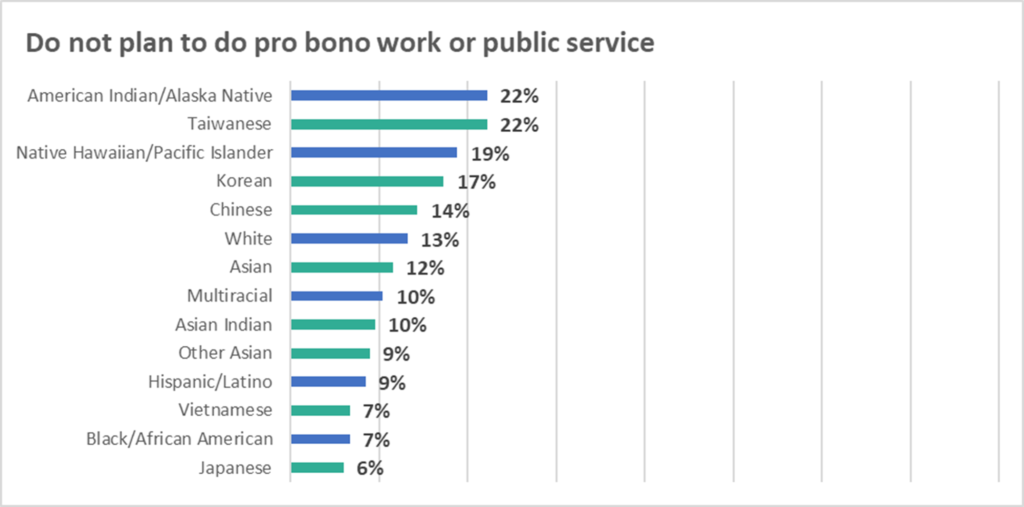
Clinical Project: The proportion of Asian Americans who have participated is the highest among all races. When broken down by ethnicity, Other Asian, Japanese, Taiwanese, and Korean American have the lowest proportion of “never” responses. On the other end, proportions of Asian Indian Americans reporting “never” (58.2%) most closely mirrors those of white students (58.3%). Finally, Vietnamese Americans have the highest proportion aside from Hawaiian/Pacific Islander reporting “never,” but they also have the second-highest proportion reporting “very often,” only behind Other Asian.
Note: The “Other Asian” label is large, with a sample size more than doubling three of the six other reported Asian ethnicities. Ideally, a Filipino category would have been useful among the ethnic breakdowns, as Filipino Americans constitute the third largest proportion of Asian Americans.
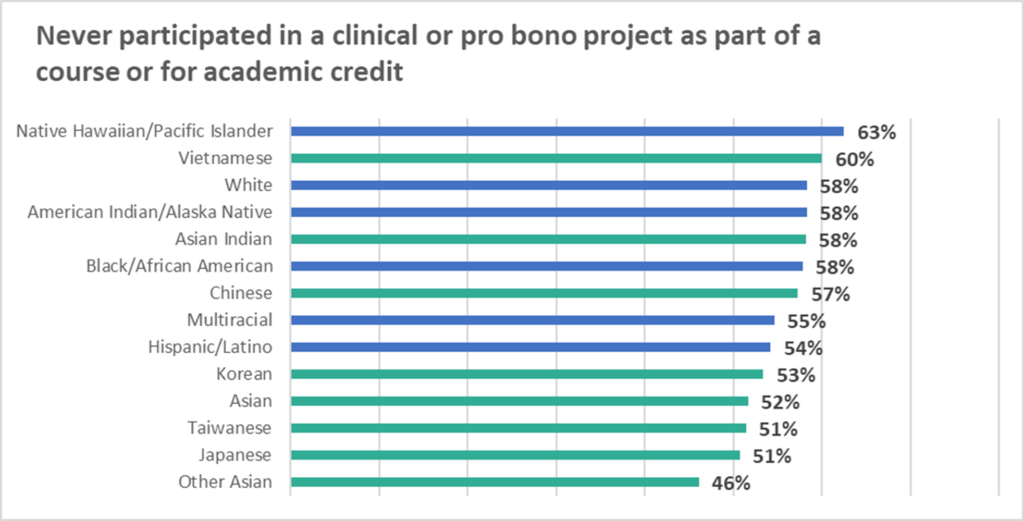
Main Takeaway
The findings reiterate how the Model Minority stereotype harmfully obscures the needs of many Asian Americans. Although the proportion of Asian Americans who contribute pro bono work is lower than other racial minorities and higher than white students, Asian ethnicities with fewer structural constraints (e.g., higher national median income, greater government representation) contribute a greater proportion of pro bono hours than Black and Latinx students, leaving students of other Asian ethnicities potentially overlooked or under-supported.
This concludes the survey portion of my thesis. To complement the survey data, I am conducting interviews with Asian American lawyers in both the public and private sectors. I hope to code the transcripts for potential public service motivation factors, uncover individual attitudes toward the public sector, and fully explore the linear and nonlinear paths of Asian Americans in law.
Huge thanks to Professor Deo and the LSSSE staff for being incredibly helpful! As an undergrad, I was astonished at how willing they were to accommodate me, and I’m so grateful for their support.
Finally, if anything piqued your interest, please don’t hesitate to contact me at aham@ucdavis.edu.
References
Chung, Eric, Samuel Dong, Xiaonan April Hu, Christine Kwon and Goodwin Liu, Yale Law School & National Asian Pacific American Bar Association, A Portrait of Asian Americans in the Law (2017).
Kochhar, Rakesh, and Anthony Cilluffo. “Income Inequality in the U.S. Is Rising Most Rapidly Among Asians.” Social & Demographic Trends Project, Pew Research Center, 12 Jul. 2018, www.pewsocialtrends.org/2018/07/12/income-inequality-in-the-u-s-is-rising-most-rapidly-among-asians/.
Sabharwal, Meghna and Iris Geva-May, “Advancing Underrepresented Populations in the Public Sector: Approaches and Practices in the Instructional Pipeline.” Journal of Public Affairs Education, 19:4, 2013, 657-679, DOI: 10.1080/15236803.2013.12001758
"U.S. Asians Have a Wide Range of Income Levels." Pew Research Center, Pew Research Center, 8 Sept. 2017, www.pewresearch.org/fact-tank/2017/09/08/key-facts-about-asian-americans/ft_17-09-08_asian_income/.
Guest Post: Student Engagement and Law School Stress
 Gary R. Pike, Ph.D.
Gary R. Pike, Ph.D.
Professor, Higher Education & Student Affairs
Indiana University
The opening scenes of the 1973 movie The Paper Chase show Professor Charles Kingsfield (played by John Houseman) sternly questioning his first-year students about the fine points of case law. Professor Kingsfield’s questioning is so intense that one student becomes physically ill. Although The Paper Chase is a work of fiction, the stress of trying to be a success in law school is very real. In her Huffington Post article, Kate Mayer Mangan reported that 96% of all law students experience high levels of stress, a rate that is much higher than rates for medical school and other graduate students. According to Mangan, law school stress appears to be a product of workload and the teaching methods used in most law schools—case-diaogue instruction. Research I just conducted using data from the 2015, 2016, and 2017 LSSSE administrations showed that law school stress played an important role in what students learn.
Stress in Law School
Stress in law school was greatest for first-year students, first-generation students, women, Latinx, and Asian American students. The amount of debt incurred in law school also increased law school stress. Likewise, students’ effort in their courses increased stress, but the extent to which students felt supported in law school reduced stress.
Student Engagement, Stress, and Learning
A goal of my research was to examine the relationships among student engagement, stress, and learning during law school. I found that both the effort students put forth in their courses and the extent to which students feel supported in law school were strongly related to both academic and personal/social gains. This finding is consistent with the findings of the National Institute of Education’s Study Group on Excellence in American Higher Education report Involvement in Learning, which concluded that both setting high standards and supporting students are necessary for student success. Law school stress had a negative effect on academic learning gains, although it was not related to personal/social learning outcomes.
Gender Differences
I also found that the relationships among student engagement, stress, and learning gains differed for males and females. First and foremost, stress had a much stronger negative effect on academic outcomes for women, compared to me. This is a serious concern because women reported significantly higher levels of stress than men. On a positive note, a supportive environment in law school tended to have a stronger effect for women than men on reducing the negative effects of stress on academic gains.
Conclusion
In sum, my research shows that stress is a serious concern in law school, particularly during the first year. Stress tends to be greatest for underrepresented groups in law school—women, first-generation students, as well as several racial/ethnic minority groups. Law school deans and other administrators and faculty members who are interested in reducing stress and reducing the negative effect of stress should focus on creating supportive environments in law school, particularly for women and minoritized groups.
____
References
Mangan, K. M. (2014, October 28). Law school quadruples the chances of depression for tens of thousands: Some changes that might help. Huffington Post. Retrieved from https://www.huffingtonpost.com/kate-mayer-mangan/law-school-quadruples-dep_b_5713337.html.
National Institute of Education Study Group on the Conditions of Excellence in American Higher Education. (1984, October). Involvement in learning: Realizing the potential of American higher education. Washington, DC: U.S. Government Printing Office. ERIC Document Reproduction Service, ED246833.
Guest Post: Connecting Bar Exam Performance to the Law Student Experience
Aaron N. Taylor
Executive Director
AccessLex Center for Legal Education Excellence
There is much research tying student engagement to academic performance. The more engaged students are, the better their academic outcomes. Little of this research, however, has been conducted in the law school context. This is a significant gap in information, particularly given the extent to which law schools must focus on outcomes, such as bar exam passage rates.
AccessLex Institute aims to fill this gap with an upcoming report summarizing our work with the AccessLex/LSSSE Bar Exam Success Initiative. The report—planned for release in Spring 2020—will present findings from analyses of factors that impact law school academic performance and first-time bar exam performance among graduates of 19 law schools that are participating in the initiative.
We considered a range of factors, including graduate demographic background; their undergraduate GPA and LSAT score; their law school grades; and responses that many of them provided on the Law School Survey of Student Engagement (LSSSE) in their third year. In all, we tested the marginal influence of over 60 engagement variables on law school grades and bar exam performance.
Understanding the factors that influence academic and bar exam outcomes can aid law schools in identifying high-impact experiences and interventions premised on student success. This insight could also help schools better design their admission processes in ways that properly contextualize admission factors and minimize overreliance on certain factors.
Across all 19 schools, measures of law school academic performance were the strongest predictors of bar exam performance. For the vast majority of schools, LSAT scores and undergraduate grades (UGPA) were partial predictors of law school academic performance. At the median level, a one-point increase in LSAT score was associated with a 0.07 increase in final law school GPA. At the median level, a one-tenth point increase in UGPA was associated with a 0.08 increase in final law school GPA (LGPA). The LSAT score had a statistically significant predictive relationship with final GPA at 18 of the 19 schools. The UGPA was tied to final GPA at 15 of the 19 schools.
The analyses also yielded interesting findings about relationships between different aspects of student engagement (as captured by LSSSE responses) and academic and bar exam performance overall and among the 19 schools. Below are three of the most notable. All of these findings yielded statistically significant relationships to final LGPA or bar exam outcome, even after controlling for the other factors in the model. Put simply, these factors were independently influential.
#1: Raise your hand if you’re……unsure.
The frequency of asking questions in class had a positive and statistically significant relationship to final LGPA. Students who reported asking questions “very often” in class had a predicted final LGPA of 3.25, while those who reported “never” asking questions in class had a predicted final LGPA of 3.18. Asking questions are a manifestation of engagement, and among the pool of students we studied, questions were associated with higher grades.
#2: Do the reading!
Unsurprisingly, coming to class unprepared was associated with lower grades. Students who reported coming to class unprepared “very often” had a predicted final LGPA that was 0.17 grade points lower than those who reported “never” coming to class unprepared. So, students: do the reading. Your grades really do depend on it.
#3: Student-faculty interaction matters
At nine of the 19 schools, the quality of relationships between students and faculty had a positive, statistically significant relationship to final GPA (the strongest predictor of bar exam outcome). Students who rated these relationships highly tended to have higher GPAs. Interactions with faculty members are central to the law student experience. How students view their professors – as teachers, as mentors, as sources of guidance and support – translates into more engagement and better outcomes.
Be on the lookout for our national report as well as a companion blog on this website providing a more in-depth discussion of key findings. This analysis will employ applied research principles and methods to provide participating schools with tangible, actionable information, including explanation and illustration of significant findings from the project and appropriate recommendations. If your law school would like to be a part of our initiatives involving student engagement and bar success, contact us at research@accesslex.org.
Guest Post: Towards Data-Driven “Deaning”
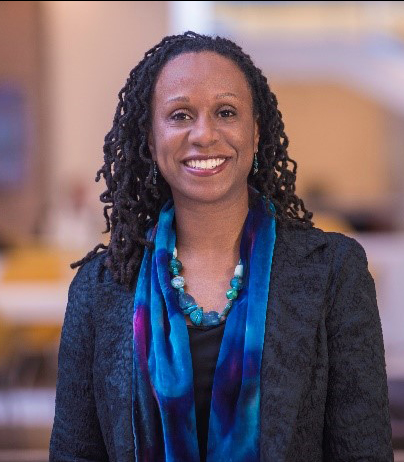 Camille A. Nelson
Camille A. Nelson
Dean and Professor of Law
American University Washington College of Law
Surprisingly, there are few opportunities as a dean to ascertain student engagement, insights, and concerns in a manner that is comparative, data-driven, and longitudinal. LSSSE presents an opportunity to intentionally harness student-derived and student-driven data in service of the aspirations of one’s law school community, and to ensure a continuous drive for excellence in a marketplace for legal education that is relentlessly competitive.
As we are often simultaneously seeking to improve metrics, especially those reported to outside entities, while ensuring the maintenance and embrace of core values in service of a shared vision, such data and information is extremely helpful. While it is not easy to move all of the needles at once, the LSSSE survey provides a good deal of information from our students as we try to improve our schools in ways that help us better serve and support our students and alumni. Having such student-centric data from our students, combined with the information on how similarly situated schools are faring along comparable trajectories is important to our ability to recognize challenges and opportunities, and to be more diagnostic in our problem solving towards informed solutions.
As the students are the heart of any great law school, it is interesting, and unfortunate, that their views are seldom collected in durable ways that provide data over time for enterprise improvement. If we take “customer service” seriously, LSSSE appears to be one of the few, if not the only, mechanism through which to glean the holistic well-being and effective functionality of the law school as a student focused enterprise over time. For instance, despite the profound impact of the US News and World Report (USNWR) on legal education, there are no input variables that are student generated in the USNWR law school rankings from which to ascertain insight into the student experience, both specifically and comparatively.
Given the dearth of student generated data available to law school administrators and faculty, LSSSE is a helpful mechanism through which to learn, analytically, as opposed to anecdotally, about the student experience and organizational pinch-points. Deans need to learn of areas in need of trouble-shooting, especially areas that might encumber student success and well-being, or which impede the creation and maintenance of durable institutional good-will. So while I recognize that no tool is perfect, LSSSE data proves valuable in providing deans with the ability to study and assess, in protensive ways, areas that must be of importance to law schools, and legal education more generally.[1]
Some may bristle at the notion of customer service in an academic setting as inappropriately consumerist, perhaps fawning and misguided. However, for many of our students, and often their families, their monetary investment in graduate and professional schools, especially given rising tuition,[2] not surprisingly, nor unreasonably, enhances expectations for such a student facing and customer-driven focus. I empathize with the impetus for assurances along the lines of customer service -- these are often fueled by increased debt loads and what some are calling a national student debt crisis.[3]
With an average annual tuition rate of $27,160 for public law schools and $47,754 for private law schools,[4] we should expect that our students want what some may view as more from us, but which may reasonably be interpreted as value for their dollar, and for their debt. For such outlays of money and the assumption of debt, would we too not do the same in every other space of personal investment and expenditure? Such expectations are especially the case in areas that bode well for student preparation for their professional opportunities, be that from wellness and counselling, to legal research, writing and the search for employment, skills that all intersect with and amplify doctrinal and substantive acumen.
In striving to be more of a data-driven dean, LSSSE can help. I look to LSSSE to help me/us improve both our appreciation of student feedback, and also to provide a basis upon which we assess our adherence to, and support of, core values we hold dear, starting with the embrace and uplift of our students.
[1] LSSSE data supports the opportunity to study various aspects of the law school experience, including how students utilize law school services, how they study, and what their employment goals are, and how it changes over time. LSSSE, http://lssse.indiana.edu/
[2] According to data compiled by Law School Transparency, average in-state tuition for public law schools in 1985 was $2,006, while average tuition for private schools was $7,526; by 2018, average tuition had risen to $27,160 and $47,754 respectively. Law School Costs, https://data.lawschooltransparency.com/costs/tuition/.
[3] Sandy Baum and Patricia Steele, Graduate and Professional School Debt: How Much Students Borrow (January 4, 2018). AccessLex Institute Research Paper No. 18-02, https://ssrn.com/abstract=3103250 or http://dx.doi.org/10.2139/ssrn.3103250; Kristin Blagg, Underwater on Student Debt: Understanding Consumer Credit and Student Loan Default (August 2018), https://www.urban.org/research/publication/underwater-student-debt/view/full_report; National Center for Education Statistics, The Condition of Education 2018 - Trends in Student Loan Debt for Graduate School Completers, https://nces.ed.gov/programs/coe/indicator_tub.asp; Federal Reserve Bank of New York, Research & Statistics Group, Quarterly Report on Household Debt and Credit, Q1 2019 (May 2019), https://www.newyorkfed.org/medialibrary/interactives/householdcredit/data/pdf/HHDC_2019Q1.pdf; Josh Mitchell, The Long Road to the Student Debt Crisis, Wall Street Journal, June 7, 2019, https://www.wsj.com/articles/the-long-road-to-the-student-debt-crisis-11559923730.
Robert Farrington, The 2020 Presidential Candidates’ Proposals for Student Loan Debt, Forbes (April 24, 2019), https://www.forbes.com/sites/robertfarrington/2019/04/24/the-2020-presidential-candidates-proposals-for-student-loan-debt/#394c0a20520e; Jacob Pramuk, Elizabeth Warren and 2020 Democrats Want to Erase Student Loan Debt – Here’s How It Could Affect the Economy, CNBC (April 23, 2019), https://www.cnbc.com/2019/04/23/elizabeth-warren-and-2020-election-democrats-propose-student-loan-relief.html Also refer to increasing conversation amongst presidential candidates about same.
[4] Law School Costs, Law School Transparency (2018 data, most recent available) https://data.lawschooltransparency.com/costs/tuition/.
Mega даркнет площадка, Mega ссылка, Мега даркнет сайт Мега даркнет площадка
Guest Post: Paying for Law School and the Public Service Loan Forgiveness Program
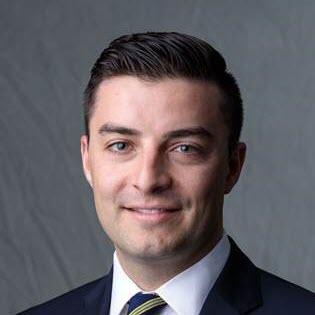 Guest Post by CJ Ryan, J.D., Ph.D.
Guest Post by CJ Ryan, J.D., Ph.D.
Associate Professor of Law, Roger Williams University School of Law
Affiliated Scholar - American Bar Foundation
Legal education in 2019 is a costly proposition for most law students. The average cost of tuition and fees at private law schools was $49,095 and $40,725 at public law schools, for out-of-state students, in the 2018-2019 academic year, to say nothing of living expenses and other costs that students pay out of pocket.[1] As a result, many law school graduates carry significant student loan debt upon completing their studies. In fact, the average amount borrowed by law school graduates totaled $115,481 for the graduating class of 2018.[2]
When discussing student loan debt, it is easy to fixate on the aggregate impact of the burdens this debt places on tax payers, the economy, and borrowers alike, such as the depressive effects that law school loan debt has on homeownership and entrepreneurship.[3] Yet, a discussion of which graduates are saddled with the largest student loans is often absent from conversations about student debt.
The results of the 2018 Law School Survey of Student Engagement (LSSSE) reveal that students from the lowest socio-economic backgrounds, as proxied by parental education, expect the greatest debt loads upon graduating from law school. In fact, among students expecting to owe between $180,000 and $200,000, 40% of these students have parents whose highest level of educational attainment was less than a baccalaureate degree, and the proportion jumps to 42% of students who expect to owe more than $200,000 in student loans from attending law school. Thus, unsurprisingly, students from the lowest socio-economic backgrounds borrow the most to finance their legal education and, perhaps as a result, are on the hook for the largest debt sums.
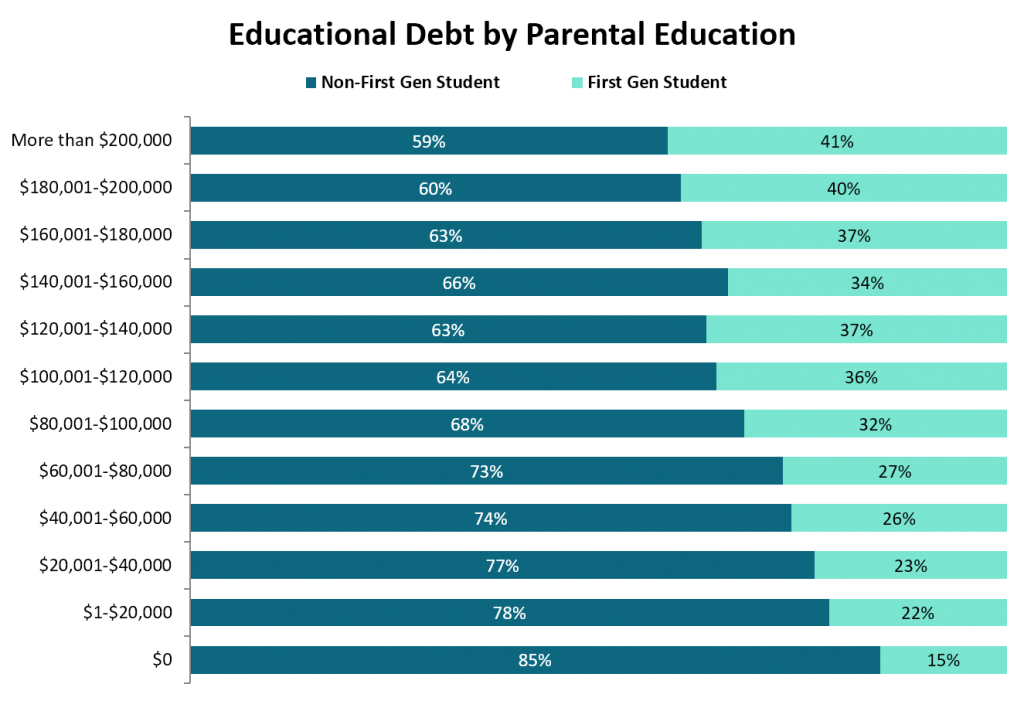
Furthermore, students from racial minority groups account for the largest expected law school debt loads. Of the students surveyed by LSSSE who expected to owe more than $200,000 in law school loans following their graduation, 53% identified with a racial group other than White. Thus, the disparate impact of the highest law school loans is greatest among racial minorities.
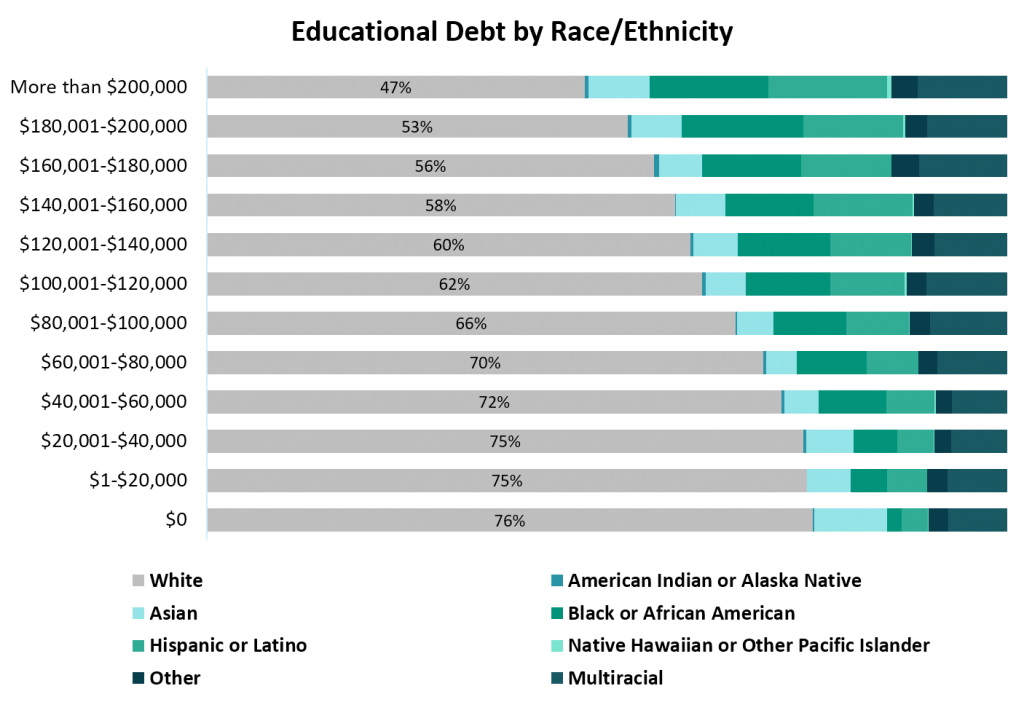
Fortunately, income-based repayment options for student loans make paying back significant debt loads for law school graduates more manageable. One repayment option, the Public Service Loan Forgiveness (PSLF) program, even forgives borrowers a portion of their student loan debt, subject to paying into the program for 10 years of full-time employment with a government organization, or a qualifying public service or tax-exempt organization under Section 501(c)(3) of the Internal Revenue Code.[4] However, the future of the PSLF remains uncertain, as the Department of Education, as well as President Trump, have announced plans to eliminate PSLF.[5]
In the fall of 2017, I administered the Law School Choice Survey at four law schools: a private elite law school; a public flagship law school; a public regional law school; and a private new law school.[6] The response rate within this sample of law students was quite robust—45%, 34%, 40% and 43%, respectively—and respondents to the survey were representative of their law school’s entire population on the basis of race and gender, within two%, in each category.[7] The survey queried current law students about their career aspirations and whether they planned to take advantage of the PSLF program to repay their student loans. Responses from students at the public flagship law school indicated that 16% of White students planned to enroll in or were already enrolled in PSLF, but 20% of the African-American students and half of the Hispanic/Latino students planned to enroll in or were already enrolled in PSLF. At the public regional law school, nearly 29% of White students indicated that they planned to enroll in or had already paid into PSLF, but half of the Hispanic/Latino students and 70% of African-American students planned to enroll in or had already paid into PSLF. At the private new law school, 33% of African-American students and over 35% of White students surveyed indicated that they plan to avail themselves of PSLF.[8] Furthermore, nearly 77% of students at the public flagship law school, and over 55% of students at the public regional and private new law schools, with expected law school loan debt exceeding $100K, indicated that they plan to enroll or were enrolled in PSLF. These results demonstrate that a significant proportion of racial minority students, as well as their White counterparts, and students with the greatest expected debt loads view the PSLF as their primary recourse for repaying their law school loans.
Likewise, 40% of the students whose parents earned a combined income of less than $50,000 annually plan to enroll or were already enrolled in the PSLF program at the public flagship law school. At the public regional law school, over 21% of students whose parents earned less than $50,000—but more than 44% of the students who parents earned less than $60,000 annually—are counting on the PSLF program. And over 58% of the students whose parents earned less than $50,000 annually at the private new law school indicated that they plan to use or are enrolled in the PSLF to repay their student loans.
Additionally, over 35% of students who planned to enter a career in traditional public interest sectors indicated that they planned to or had already enrolled in PSLF.[9] More than 54% of students who sought a career in a public interest sector at the public regional law school indicated that PSLF was a part of their loan repayment plans. And over 30% of students at the new private law school who plan to enter a career in the public interest sector reported that they plan to repay using PSLF.
Taken together, these results suggest that that the students who most need relief for their substantial law school loans—students from lower socio-economic backgrounds, students from diverse racial backgrounds, students considering careers in public interest law, and students carrying the highest debt loads, most of whom are the same students across these four categories—are the students most likely to enroll in the PSLF program. Thus, despite the administrative challenges associated with the PSLF program,[10] it has succeeded in attracting law graduates to careers in the public interests, and particularly racial minority law graduates.[11] As such, it presents the most viable path to ensuring diversity in the legal profession, in terms of socio-economic status and race, but it also has substantial implications for ensuring access to justice. PSLF provides an important pathway for lawyers willing to serve in public interest roles, often at dramatically lower salaries than their peers who pursue careers in the private sector, to repay their loans, while helping to address the unmet demand for legal services for those with the greatest need in our society.[12] To eliminate the PSLF program, and these important goals that it accomplishes, would be a mistake.
____
[1] See, e.g., Ilana Kowarski, See the Price, Payoff of Law School before Enrolling, U.S. News & World Report, March 12, 2019, https://www.usnews.com/education/best-graduate-schools/top-law-schools/articles/law-school-cost-starting-salary.
[2] Law School Costs, Law School Transparency, https://data.lawschooltransparency.com/costs/debt/.
[3] Alvaro Mezza, Daniel Ringo, and Kamila Sommer, Can Student Loan Debt Explain Low Homeownership Rates for Young Adults?, Federal Reserve Board, January 2019, https://www.federalreserve.gov/publications/files/consumer-community-context-201901.pdf; see also, Vadim Revzin and Segei Revzin, Student Debt Is Stopping U.S. Millenials from Becoming Entrepreneurs, Harvard Business Review, April 26, 2019, https://hbr.org/2019/04/student-debt-is-stopping-u-s-millennials-from-becoming-entrepreneurs.
[4] The Public Service Loan Forgiveness Program, Federal Student Aid, https://studentaid.ed.gov/sa/repay-loans/forgiveness-cancellation/public-service#qualifying-employment.
[5] Zack Friedman, Trump Proposes to End Student Loan Forgiveness Program, Forbes, March 12, 2019, https://www.forbes.com/sites/zackfriedman/2019/03/12/trump-proposes-to-end-student-loan-forgiveness-program/#3cb3d8e5415e.
[6] See Christopher J. Ryan, Jr., Analyzing Law School Choice, 2020 Ill. L. Rev. ___ (forthcoming 2020), available at https://papers.ssrn.com/sol3/papers.cfm?abstract_id=3309815. As a condition of their participation in the survey, the law schools at which the survey was administered asked to remain anonymous and only be identified by descriptive terms. The administration at the private elite law school would not permit me to ask whether students at the law school were planning to enroll or had already paid into the PSLF program; however, all other survey questions were common between law schools.
[7] See id.
[8] Curiously, no Hispanic/Latino students surveyed at the new private law school indicated that PSLF was included in their loan repayment plans but both of the Asian-American law students surveyed indicated that they planned to enroll or were enrolled in the PSLF program. However, it should be noted that the private new law school is not terribly diverse in terms of race.
[9] These law career sectors included: children’s law/ juvenile justice; civil liberties and civil rights; criminal law; education law; employment/labor law; family law; general legal services; government law; housing law; immigration law; and public interest law.
[10] Zack Friedman, 99.5% of People Are Rejected for Student Loan Forgiveness Program, Forbes, January 3, 2019, https://www.forbes.com/sites/zackfriedman/2019/01/03/student-loan-forgiveness-data/#14c9cb3e68d0.
[11] See, e.g., Public Service Loan Forgiveness Data, Dept. of Educ., March 2019, available at https://studentaid.ed.gov/sa/about/data-center/student/loan-forgiveness/pslf-data.
[12] For example, it is estimated that legal aid lawyers “are estimated to provide just 1 percent of the total legal needs in the United States each year[.]” Three Ways to Meet the “Staggering” Amount to Unmet Legal Needs, Am. Bar Ass’n J., June 26, 2018, https://www.americanbar.org/news/abanews/publications/youraba/2018/july-2018/3-ways-to-meet-the-staggering-amount-of-unmet-legal-needs-/.
Guest Post: Using LSSSE Data to Determine Which Law School Activities Impact Student-Reported Gains in Writing Skills
 Guest Post by Kirsten Winek, J.D., Ph.D.
Guest Post by Kirsten Winek, J.D., Ph.D.
Manager, Law School Analytics and Reporting
American Bar Association Section of Legal Education and Admissions to the Bar
Successfully completing a dissertation is never easy. However, perseverance, coffee, and robust data can make the process manageable. LSSSE was invaluable to my dissertation research, since it collects information on the activities of law students nationwide as well as their evaluation of how the law school experience contributed to their gains in writing skills.
Having previously worked in law school career services, I was familiar with criticisms that law students and graduates lacked the writing skills needed for law practice. A review of the legal education literature turned up studies that delved into this issue and affirmed this was a problem. As such, I decided to focus my dissertation research on determining which law school activities impacted law students’ self-reported gains in writing skills since this information could help law schools prepare their students for the writing required in law practice and on the bar exam. My data came from the 2018 LSSSE administration, which surveyed law students about numerous law school activities and asked them to evaluate the extent their law school experience contributed to their writing skills gains. I limited my sample to all full-time, third-year LSSSE takers as they would have had the opportunity to take upper-level writing courses, legal clinics, and writing-centric extracurricular activities such as Law Review and Moot Court.
To frame my research, I used Alexander Astin’s Involvement Theory. This theory posits that the more students involve themselves in their higher education experience, the more they learn and grow from that experience. Thus, students who participate more in their law school experience may realize skills gains from that experience. To guide my data analysis, I used Alexander Astin’s I-E-O model (Inputs-Environment-Outcomes). Inputs are the attributes students bring with them to higher education, environment is all the pieces of the higher education experience, and outcomes are the skills and attributes students have at the end of the higher education experience.
Although Astin developed the aforementioned frameworks using undergraduate students, both can be applied to law students and work quite well with LSSSE data. LSSSE is based on student engagement theory, which is very similar to Astin’s Involvement Theory. LSSSE gathers the data needed for the inputs, such as LSAT scores, undergraduate GPA, race/ethnicity, gender identity, age, and parental education. To encompass the law school environment, LSSSE asks students dozens of questions about their courses and class preparation, co-curricular activities, interactions with peers and faculty, and satisfaction with various aspects of law school. Finally, for the outcome of this study, LSSSE provided information on law students’ self-reported writing gains via the question asking students to evaluate the contributions their law school experience made to their writing skills.
After running the LSSSE data through a stepwise multiple regression analysis, several statistically significant predictors of student self-reported writing gains emerged. I will focus on the four strongest predictors here.
Interestingly, the four strongest predictors of law student self-reported gains in writing skills were actually self-reported gains in other skills. The extent to which students’ law school experience contributed to their skills in 1) speaking clearly and effectively, 2) thinking critically and analytically, 3) developing legal research skills, and 4) acquiring job or work-related knowledge and skills, respectively, all positively impacted student self-reported writing gains.
What are the implications of these findings for law schools? The fact that gains in three different skills (speaking, thinking, and researching) each had a positive relationship to self-reported writing gains revealed that writing skills are not learned in a vacuum – they are developed together with other skills. Critical and analytical thinking as well as legal research are essential parts of legal writing, and preparing for an oral argument or presenting on one’s written work may help in the writing process, too. Therefore, when possible, writing should be taught or practiced in conjunction with speaking, critical and analytical thinking, and legal research since these skills each had a positive impact on student self-reported gains in writing. Introductory legal writing courses usually combine all these skills, but this approach may not be practical in upper-level courses that do not have writing as a focal point. However, faculty teaching a seminar course that includes a paper or supervising student law review articles could require students to orally present on their work so they involve all three skills, as legal research and critical and analytical thinking are already key parts of these writing assignments.
Additionally, the positive relationship between student self-reported gains in work or job-related skills and student self-reported gains in writing is unsurprising given the prominent role writing plays in legal practice. Law schools should stress to students how important good writing is for legal practice, as well as for success on the bar exam, and ensure they learn and practice writing skills throughout their time in law school.
These selected findings from my dissertation research provide a look at the valuable insights LSSSE can provide to researchers and legal education. These implications should encourage law schools to maintain or increase the work they may already do in helping their students learn or practice legal writing skills.
Guest Post: Be True to Your School: But True to Your Law School?
Guest Post by Stephen Daniels
Senior Research Professor
American Bar Foundation
Be True to Your School was a popular song of an earlier time extolling staunch loyalty to one’s alma mater. But staunch loyalty to your law school these days in light of high tuition, high student debt, concerns about inadequate preparation, and mediocre job prospects? Two recent reports drawing from retrospective surveys of graduates done by Gallup – one as a part of the Gallup-Purdue Index and the other done in conjunction with AccessLex Institute – suggest that many see little value in their legal education given the cost. Those choosing to attend law school make a substantial investment with the expectation of a substantial return. Is there value in the proposition? Is there cause to be true to your school?
I do research on legal education from an institutional perspective and the question about value animates much of my current work involving law students.[1] Students – or more precisely, their tuition dollars – are indispensible for legal education. The LSSSE survey data allow me to explore students’ views over time in search of an answer for that question.
The LSSSE data are important because they provide not just information about students, but information from students. Simply put, the surveys give voice. The data are especially unique because they are longitudinal, the surveys asking students a host of questions over time using the same wording – the gold standard for examining change, or the lack thereof, in views, attitudes, or assessments.
Although the data do not cover all schools, and LSSSE does not claim to have a representative sample of all schools or students, the range of participating schools is wide. The number of respondents in any given year or set of years is large. The 2016 survey, for example, had over 18,000 respondents from 72 schools; in 2010 the figures were just under 23,500 from 73 schools.
My current project using the LSSSE data – Be True to Your School: But True to Your Law School? – explores patterns and changes in law student assessments of their schools. The question about being true to one’s school provides a framework, a heuristic for exploring a range of factors important to students given the investment they are making. In that old song, what made you true to your school was its winning football team. What makes a law student true to their school is the school’s success in meeting their expectations – enough, to paraphrase a LSSSE survey question, that the student would attend that school again if given the choice.
The data I utilize cover the years 2005 through 2016. They include respondents from 38 schools participating in the LSSSE surveys at least three times between 2005 and 2010, and at least three times between 2011 and 2016 (allowing for comparisons before and after the 2010 enrollment peak and subsequent decline). Focusing on those 38 schools—which were not identified, just as the students themselves remain anonymous—provides a reasonable degree of continuity. Not all respondents from those schools are included, just those at the end of their law school experience (usually 3Ls and occasional part-time students who take a fourth year (4Ls) to complete their studies). Structured this way the data set consists of 33,661 survey respondents.
Are 3/4Ls at least reasonably true to their schools? In apparent contrast to the Gallup surveys, preliminary analyses suggest yes – at least in general. Most respondents said they (probably or definitely) would attend the same school again.
Affirmative Answers to Select LSSSE Questions by Time Period
(3/4L respondents in 38 schools)
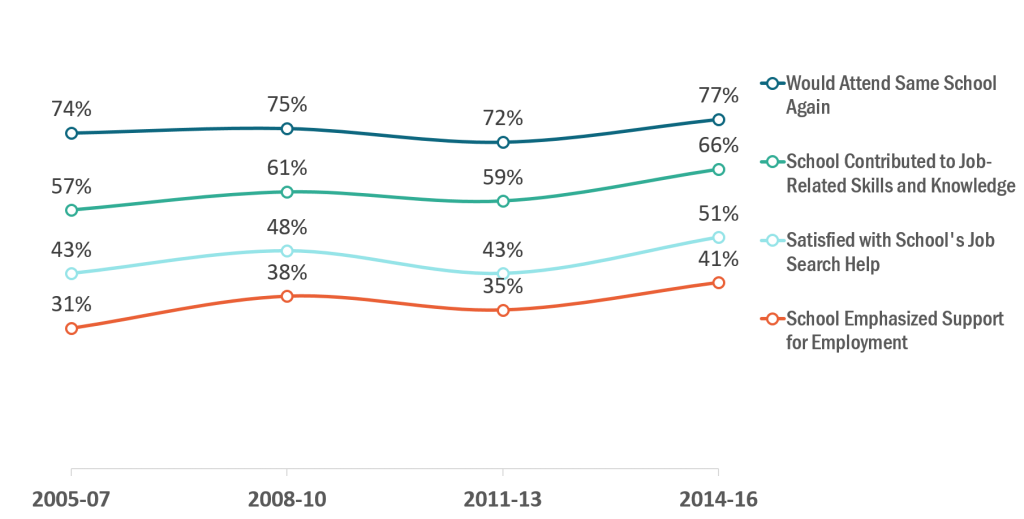
Additionally, the percentages reflect some stability over time with regard to attending the same school again. The 2011-13 dip reflects the cohort graduating as the post-2010 enrollment declines began, with the next cohort having a somewhat more positive view. It was the effect of a drop in affirmative responses from private school students (from 75% in 2008-10, to 69% in 2011-13). There was no similar decline for public schools (81% in 2011-13, 85% in 2014-16 to 80%). Not surprisingly, the most important factor for an affirmative answer about attending the same school again was a student’s evaluation of their overall law school experience.[2]
While attending the same school is a summary question close to the Gallup surveys’ interest in value, other LSSSE questions probe the idea of value more deeply and are more revealing of the complexities of students’ views. One question asks the extent to which the law school contributed to acquiring work-relevant knowledge and skills. The graph shows that a majority responded affirmatively about their school’s contribution, with an upward trend except for another 2011-13 dip (again, private schools).
This particular contribution was especially important for those respondents saying they would attend their school again, as 70% also answered affirmatively about their school’s contribution to work-relevant knowledge and skills. For those not so interested in attending their school again, only 37% thought their school made that contribution.
Another two questions ask about crucial employment-related matters. One question asked about satisfaction with the school’s help in finding a job for those using it (86% did use that help). As that column shows, most respondents were not enthusiastic in their assessments (with the 2011-13 dip). Students who would not attend their school again were even less enthusiastic about the help provided -- the percentage of them offering a positive assessment ranged only from 20% in 2005-07 to 25% in 2008-10.
The other employment-related question asked about the degree of a school’s support for the student’s own employment search. Most respondents did not find their schools particularly helpful in this regard (with the 2011-13 dip). Those who would not attend their school again were even more negative in their assessments on support. Their assessments ranged from only 11% in 2005-07 to 18% in 2014-16. Even a majority (57%) of those who would attend their school again had a negative assessment of their school on this matter.[3]
The responses to these three questions reflect longer-term areas for concern and may provide a hint as to why respondents in the Gallup retrospective surveys were doubtful about the value of their investment. Again, these are preliminary findings from a project very much in progress, with much left to do. What is clear is the importance of the LSSSE data for digging systematically into the details of what students say about the value of their investment.
[1] Funded in part by a grant from AccessLex Institute.
[2] Spearman’s rho =.68, sig.=.000.
[3] Responses to the employment questions are strongly related, Spearman’s rho = .74, sig. = .000.
Guest Post: LSSSE as a Key Tool to Support the Learning Outcomes Enterprise

Guest Post by Jerry Organ
Professor of Law and Co-Director of the Holloran Center for Ethical Leadership in the Professions
University of St. Thomas School of Law (Minnesota)
In 2014, the ABA Section of Legal Education and Admissions to the Bar mandated that law schools adopt learning outcomes. As of March 1, 2019, over 180 law schools have published learning outcomes on their websites. The Learning Outcomes Database on the website of the Holloran Center for Ethical Leadership in the Professions -- https://www.stthomas.edu/hollorancenter/resourcesforlegaleducators/learningoutcomesdatabase/ --provides a searchable set of databases of publicly available law school learning outcomes organized under three categories -- learning outcomes associated with
- Standard 302(a) (knowledge and understanding of substantive and procedural law),
- Standard 302 (b) and (d) (legal analysis and reasoning, legal research, problem-solving, and written and oral communication in the legal context (b) along with other related professional skills (d)), and
- Standard 302 (c) and (d) (exercise of proper professional and ethical responsibilities to clients and the legal system (c) along with other related professional skills (d)).
The learning outcomes enterprise contemplates that each law school will engage in an assessment process in which it analyzes the extent to which its program of legal education is helping its law students progress on the law school’s identified learning outcomes. Having engaged in that assessment effort, the law school then should “close the loop” and figure out whether it needs to make changes in its program of legal education to improve the extent to which its students are making progress on the law school’s identified learning outcomes. This is an iterative process that should result in continual improvement over time in the extent to which the program of legal education is helping students progress on the identified learning outcomes.
Law schools may feel that there are some traditional measures that can be used to assess progress on learning outcomes associated with Standards 302(a) and 302(b), such as performance in doctrinal courses and legal research and writing, and possibly performance in experiential courses and clinics, and performance on the bar exam. A significant number of law schools, however, have identified robust professional formation learning outcomes associated with Standard 302(c) and 302(d) for which these traditional measures may not be very helpful, including self-directedness, cultural competence, commitment to pro bono, teamwork/collaboration, and integrity among others.
LSSSE can be an important tool to support the assessment efforts associated with the learning outcomes enterprise, particularly with respect to some of these “professional formation” learning outcomes.
First, within the LSSSE survey instrument itself, there are a number of questions that relate to some of the learning outcomes identified above.
With respect to cultural competence, for example, the following questions could be informative:
- How often have you had serious conversations with students of a different race or ethnicity than your own?
- How often have you had serious conversations with students who are very different from you in terms of their religious beliefs, political opinions, or personal values?
- How often have you included diverse perspectives (different races, religions, sexual orientations, genders, political beliefs, etc.) in class discussions or writing assignments?
- To what extend does your law school emphasize encouraging contact among students from different economic, social, sexual orientation, and racial or ethnic backgrounds?
- To what extent has your experience contributed to your understanding people of other racial and ethnic backgrounds?
While these questions do not speak directly to a student’s level of cultural competence, they can inform whether various interventions or curricular or co-curricular innovations a school has implemented have resulted in more interactions among students of diverse backgrounds and can measure the perception of the school’s commitment to emphasizing interactions among students of diverse backgrounds.
With respect to commitment to pro bono, there are four questions that could be used to assess the extent to which engagements or interventions around pro bono have had a meaningful impact in the student experience:
- How often have you participated in a clinical or pro bono project as part of a course or for academic credit?
- Have you done pro bono work or public service?
- How many hours do you spend in a week on legal pro bono work not required for a class or clinical course?
- To what extent has your experience contributed to your contributing to the welfare of your community?
With respect to teamwork/collaboration, there are a handful of questions that could be instructive:
- How often have you worked with other students on projects during class?
- How often have you worked with classmates outside of class to prepare class assignments?
- To what extent has your experience contributed to your working effectively with others?
Similarly, the following questions may be instructive with respect to integrity:
- To what extent does your law school emphasize encouraging the ethical practice of the law?
- To what extent has your experience contributed to your developing a personal code of values and ethics?
- To what extent has your experience contributed to your understanding yourself?
As noted above in the discussion regarding cultural competence, many of these questions are not direct measures of one’s attitudes or capabilities. Rather they serve as indirect measures of how the students experience the law school culture and the extent to which that culture provides certain opportunities or experiences for students. For law schools trying to determine whether a given change in course requirements or instructional methodologies or co-curricular programming has had a meaningful impact, these indirect measures can be a helpful supplement to other measures, such as observations of students or reflective writing.
Second, LSSSE supports supplemental question sets or modules. This use of modules might be an even more powerful mechanism for supporting the assessment process regarding some of these professional-formation learning outcomes. The module concept generally contemplates that multiple law schools would ask a supplemental set of questions usually focused on a common theme or attribute. Thus, several law schools that each had a learning outcome associated with commitment to pro bono or teamwork/collaboration or self-directedness could come up with a bank of additional questions focused more significantly on one of those learning outcomes. This “module” could then be used at each of those law schools to get feedback that is law school specific and comparative.
The most fruitful mechanism for using either existing questions or modules is to participate in multiple iterations of the LSSSE, such as bi-annually, which allows a school to see comparisons over time on two platforms. First, one can assess the change between first-year and third-year, for example. Second, one can assess change among first-years and third-years over time. This can be an especially effective way to assess whether a change in curricular offerings or co-curricular programming has had a meaningful impact.
The simple point I want to communicate is that law schools need to be thinking about LSSSE as a real partner in the learning outcomes enterprise. In addition, law schools should be thinking about working in partnership with other law schools and LSSSE on modules that could make LSSSE an even more powerful assessment tool.
Guest Post: Antecedent Experiences Affecting Belonging in Law School
Guest Post By Elizabeth Bodamer, J.D.
Director of Student Affairs, Indiana University Maurer School of Law
PhD Candidate, Indiana University Bloomington Department of Sociology
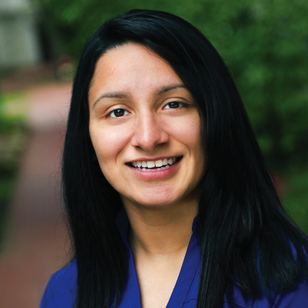 As a graduate student, I am very fortunate to have the opportunity to work with LSSSE and other collaborators to explore in-depth the student experience in American law schools today. Last month, Professor Quintanilla shared the LSSSE data finding that the quality of relationships with faculty, staff, and students predicts students’ sense of belonging. Moreover, the data showed that belonging predicts students’ academic performance. Building upon this research, my dissertation will look at the antecedent experiences that affect belonging in law school.
As a graduate student, I am very fortunate to have the opportunity to work with LSSSE and other collaborators to explore in-depth the student experience in American law schools today. Last month, Professor Quintanilla shared the LSSSE data finding that the quality of relationships with faculty, staff, and students predicts students’ sense of belonging. Moreover, the data showed that belonging predicts students’ academic performance. Building upon this research, my dissertation will look at the antecedent experiences that affect belonging in law school.
In my dissertation, I argue that minoritized students must perform a balancing act as they navigate their way through school environments and negotiate their sense of belonging in law school. I suspect that the balancing act will be seen when the effects of negative experiences and perceptions are counteracted by students' support systems. As students are pulled negatively one way, their support system pushes them back up on the law school balance beam. They teeter between their negative experiences and perceptions and their support systems.
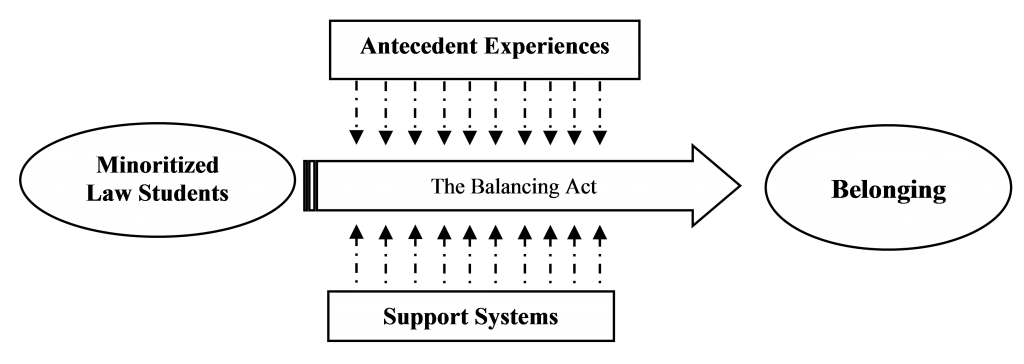
Preliminary findings illustrate that student experiences in law school vary by race/ethnicity, gender, and sexual orientation. For example, students from 20 law schools were asked to indicate how strongly they agree or disagree with the following statement: “I have experienced bias, discrimination, or unfair treatment at my law school based on my race/ethnicity, gender, gender identity, and/or sexual orientation.” 19.42% of students who identified as gay, lesbian, bisexual, another, and/or questioning and 18.11 % of nonwhite students reported having experienced bias, discrimination, or unfair treatment at their law school. This is almost double of what white students (10.49%) and male students (10.56%) reported.
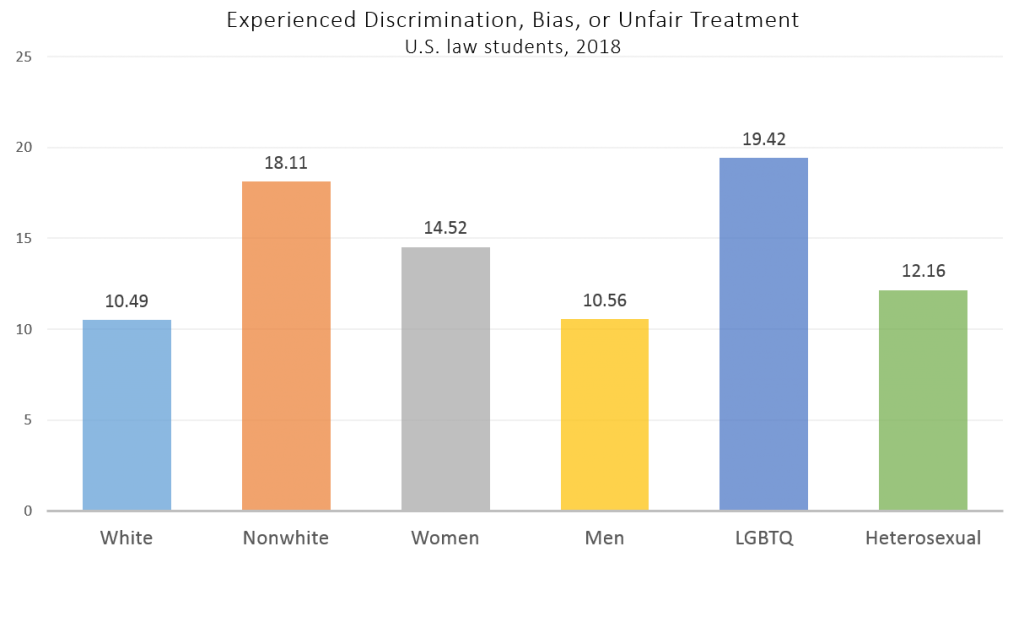
A similar pattern is seen when students were asked to indicate how strongly they agree or disagree with the following statement: “I experienced not being taken seriously in a class because of my race/ethnicity, gender, gender identity, and/or sexual orientation.” 22.54% of nonwhite students, 19.73% of women, and 20.25% of students who identified as gay, lesbian, bisexual, another, and/or questioning reported not being taken in class. 9.89% of male students and 12.36% of white students reported having not been taken seriously in class. Compared to white and male students, significantly more minoritized law students reported not being taken seriously in a class because of their race/ethnicity, gender, gender identity, and/or sexual orientation.
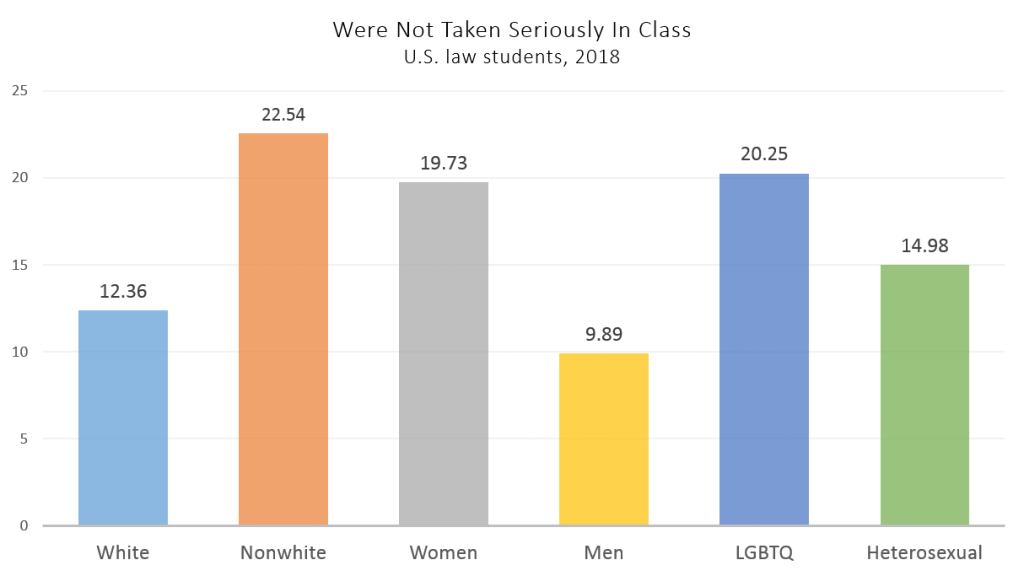
Why does this matter? Higher education literature shows that peer support, social and academic interaction, perceived racial tension, relationships, friendships, a solid support system, and climate affect students’ sense of belonging (Green et al. 2018; Murphy and Zirkel 2015; Freeman, Anderman, and Jensen 2007; Pittman and Richmond 2008; Hausmann et al. 2007; Hurtado and Carter 2007; Cabrera et al. 1999). It is important not to simply understand that experiences vary based on race/ethnicity, gender, and sexual orientation, but to explore if and how these experiences have a direct effect on belonging, and consequentially on students’ performance. Examining the student experience is crucial because as Duncan Kennedy said, “One cannot grasp the political significance of legal education without understanding that the future is present within every moment of a student’s experience.”
I look forward to continuing my work with the LSSSE dataset as I analyze how negative experiences and perceptions, such as discrimination experiences, perception of how students are perceived, and perception of school’s commitment to diversity, and support systems directly affect belonging in legal education.
Happy 15-year anniversary, LSSSE!
* Dissertation Committee: Dr. Ethan Michelson, chair (Indiana University Bloomington), Dr. Jennifer Lee (Indiana University Bloomington), Dr. Sylvia Martinez (Indiana University Bloomington), and Victor Quintanilla (Indiana University Maurer School of Law).
**One of the many challenges graduate students face in doing research is finding the data necessary to answer their research questions. However, collaborating with LSSSE has allowed me to collect the necessary data to explore the overarching question, what affects law students’ sense of belonging. For this, I would like to thank the LSSSE dream team, Chad, Jakki, and Meera, for working with me to make this dissertation data possible.
Guest Post: A LSSSE Collaboration on the Role of Belonging in Law School Experience and Performance
Guest Post By Victor D. Quintanilla, Professor at Indiana University Maurer School of Law, co-Director of the Center for Law, Society & Culture
 This year is the 15th anniversary of the Law School Survey of Student Engagement (LSSSE). In just a short decade and a half, LSSSE has collected over 350,000 law student responses from 200 law schools forming one of the largest datasets that captures law student voices and experiences in law school. My collaborators and I are grateful for the opportunity to share how we harnessed LSSSE’s remarkable dataset to illuminate student experiences with the aim of improving legal education.
This year is the 15th anniversary of the Law School Survey of Student Engagement (LSSSE). In just a short decade and a half, LSSSE has collected over 350,000 law student responses from 200 law schools forming one of the largest datasets that captures law student voices and experiences in law school. My collaborators and I are grateful for the opportunity to share how we harnessed LSSSE’s remarkable dataset to illuminate student experiences with the aim of improving legal education.
For the past three years, I have been working with an interdisciplinary team of researchers across several institutions—including Indiana University Bloomington, the University of Southern California, the University of California at Los Angeles, Wake Forest University, and Stanford University—to examine the under-recognized role that psychological friction plays in law school engagement and performance.
Psychological friction can manifest in several ways, including feeling isolated, stereotyped, or feeling that one doesn’t belong (academically, culturally, or socially). These feelings of non-belonging shape the psychological experiences and achievement of students (e.g., Walton & Cohen, 2007; 2011). In 2018, in collaboration with LSSSE, we added validated survey items to a pilot LSSSE module to examine students' experiences of belonging, belonging uncertainty, and stereotype threat in law school. Indeed, this kind of collaboration is just one example of the many fruitful ways that researchers interested in studying legal education can work with LSSSE to conduct important empirical research on legal education.
The Role of Social Belonging in the Transition to Law School
All students face challenges in the transition to law school, from developing new friends, to learning the legal concepts and professional skills explored in first-year courses, to building relationships with professors. But law students from disadvantaged social backgrounds, including racial and ethnic minority students and first-generation college students, may wonder whether a "person like me" will be able to belong or succeed in law school and the profession. One consequence is that when disadvantaged law students encounter common difficulties in the critical first weeks and months of law school—such as critical feedback from professors using the Socratic method, difficulty reading cases and materials, difficulty with legal writing exercises, or an absence of feedback—these difficulties can be interpreted as evidence that they may not belong or can’t succeed. This negative inference can become self-fulfilling for all students—and especially for students from disadvantaged social backgrounds.
These worries about belonging and potential are endemic in legal education, occurring at all stages of students’ early legal careers—from the transition to law school, to mastering daunting course material, to the disciplined synthesizing of information required during bar exam preparation.
When students worry that they may not belong in law school, they are more likely to experience anxiety that can interfere with learning and are less likely to reach out to faculty, join study groups, seek out friends, or succeed in the law school environment over time. As such, feelings of belonging may be one important predictor of law school engagement and success.
By analogy, one study with a large group of undergraduate students found that pre-college worries about belonging in college (e.g., "Sometimes I worry that I will not belong in college.") predicted full-time college enrollment the next year, even controlling for high school GPA, SAT-score, fluid intelligence, gender, and other personality differences (Yeager et. al., 2016).
Where do these worries about belonging come from? The quality of students’ social relationships in school is an important predictor of students’ sense of belonging in school (Murphy & Zirkel, 2015; Walton & Cohen, 2007). The quality of students’ social relationships in school shapes students’ experiences and academic outcomes. Students who have strong, positive relationships with peers and professors are more satisfied with their educational experiences, more academically motivated, perform better in school, and are less likely to drop out (Wilcox & Fyvie-Gauld, 2005; Kuh & Hu, 2001).
LSSSE Data Reveals The Importance of Social Belonging in Law School
Our research team adapted validated survey items measuring social belonging and its potential antecedents for the 2018 administration of the LSSSE survey. In this pilot module, over 4,000 students rated their experiences of belonging and belonging uncertainty by responding to items such as, "I felt like I belonged in law school," and "While in law school, how often, if ever did you wonder: 'Maybe I don’t belong in law school?'"
What did we find? First, we found that the quality of relationships with faculty, students, and administrators significantly predicted students’ feelings of belonging in law school. Thus, students’ relationships in law school predict their sense of belonging there.
Did law school belonging predict students’ performance? Yes. Indeed, a sense of belonging significantly predicted students’ overall experience in law school, whether they would choose to go to law school again, and their academic success (i.e., law school GPA) above and beyond traditional predictors such as LSAT scores and undergraduate GPA. Thus, law school belonging is a critical predictor of social and academic success among law students (Quintanilla, et. al, in prep).
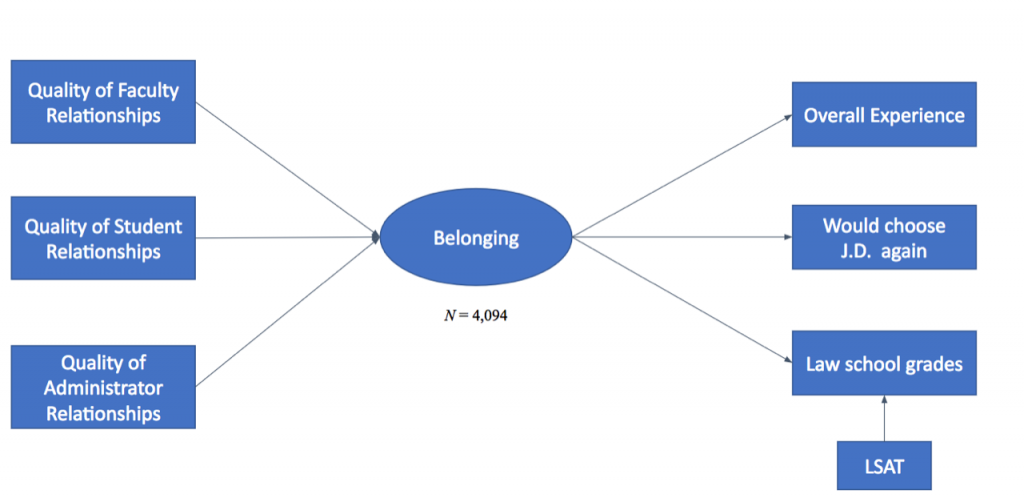
Psychological Friction and WISE Interventions
While law schools seek to enhance and maintain student success, an almost-exclusive focus on cognitive predictors of success neglects other important social, contextual, and psychological factors—such as belonging in law school. Using LSSSE data, our research team found that students’ sense of belonging influences their law school satisfaction and grades, above and beyond the effects of LSAT score. We believe that law schools may be fertile grounds for social psychological interventions. "Wise interventions" focus on changing students’ construals of their environment (Walton & Wilson, 2018), and these may improve students’ sense of belonging and academic performance in law school—especially when coupled with changes in some of the structures and practices that dampen relationships and belonging in law school.
We look forward to continuing our collaboration with LSSSE and celebrate the continued growth of empirical legal education research that LSSSE affords. Congratulations to LSSSE on its 15-year anniversary!
*This research program and the design of related interventions are being conducted in collaboration with: Dr. Sam Erman (co-PI, University of Southern California), Dr. Mary C. Murphy (co-PI, IU Bloomington), Dr. Greg Walton (co-PI, Stanford University), Elizabeth Bodamer (IU Bloomington), Shannon Brady (Wake Forrest College), Evelyn Carter (UCLA BruinX), Trisha Dehrone (IU Bloomington), Dorainne Levy (IU Bloomington), Heidi Williams (IU Bloomington), and Nedim Yel (IU Bloomington), and supported by funding from the AccessLex Institute.





